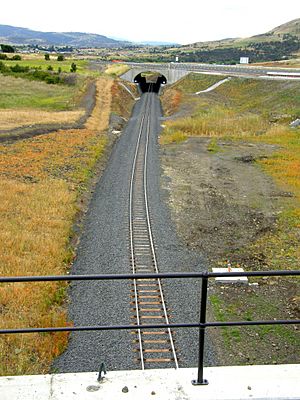South Line, Tasmania facts for kids
Quick facts for kids South Line |
|
|---|---|

The South Line, travelling north under
the newly completed Brighton Bypass. |
|
| Overview | |
| Owner | Government of Tasmania |
| Termini | Hobart railway station Bell Bay Line Western Line |
| Service | |
| Type | Heavy rail |
| Operator(s) | TasRail |
| History | |
| Opened | 1876 |
| Technical | |
| Track length | 199.1 km (123.7 mi) |
| Track gauge | 1,067 mm (3 ft 6 in) |
The South Line is a very important railway line in Tasmania. It is also known as the Main Line or the North–South Line. This railway connects the city of Hobart in the south to the ports in northern Tasmania. The Tasmanian Main Line Company built this railway.
Contents
History of the South Line
Building the Railway
When the railway was being built, the company did not have a lot of money. Because of this, the line was built using a 1,067 mm (3 ft 6 in) Narrow Gauge. This means the tracks were closer together than standard tracks. The line also had many steep hills and sharp turns.
The last 18 kilometres of the line, from Western Junction to Launceston, used tracks that were already there. These older tracks were a wider size. So, a third rail was added to let the narrower trains use them. The South Line officially opened on 1 November 1876.
Changes Over Time
Tasmania has a very good road network and many trucks that move goods. Because of this, the railway line has not changed much in its 125-year history. Even though the path of the line is mostly the same, the tracks themselves have gotten much better.
Today, the railway uses stronger, longer pieces of metal for the tracks. These pieces are welded together. The wooden sleepers that hold the tracks in place have been replaced with steel ones. The gravel under the tracks, called ballast, has also been improved.
Modern Use and Future Plans
The South Line is still used today. Many freight trains travel on it almost every day. These trains usually go from Burnie to Boyer, and from Burnie or Launceston to Hobart and back.
The last freight train left Hobart Station on 22 June 2014. After that, a new special place called the Brighton Transport Hub became the main stop for goods trains.
The part of the railway line that goes through inner Hobart is not used for freight anymore. People are talking about using this part of the line for a new light rail system in Hobart. This would help people travel around the city more easily. This idea has been called Riverline or the Northern Suburbs Railway.
In 2023, special passenger trains started running on the line again. The Tasmanian Transport Museum operates these trains with help from the Tasmanian Government.
South Line Route
Starting Point in Hobart
The South Line begins at the Hobart intermodal Terminal. This is located at Macquarie Point, right on Hobart's waterfront. From there, the line follows the western side of the River Derwent.
Crossing the River
The railway continues along the river until it reaches Bridgewater. Here, the line crosses the river on the Bridgewater Bridge.
Journey North
After crossing the river, the line generally heads north-east. It goes through easier land until it reaches Rekuna, which is between Tea Tree and Campania.
From Rekuna, the railway starts a difficult climb. The path often becomes steep and winding. Train crews get little rest until they pass Rhyndaston. This area includes the 955-metre long Rhyndaston Tunnel, which is about 28 kilometres later.
Descent and Connections
The way down from near Parattah is not as steep as the climb from the south. However, it still has some challenging parts. This includes the Tin Dish and Nala deviations. These were built in the 1930s to make the hills less steep. But, they also added more curves to the track in some places.
North of Antill Ponds, the railway runs next to the Midland Highway. Both follow the rich farming valleys created by the Macquarie and South Esk rivers. The South Line ends at Western Junction near Evandale. Here, it connects with the Western Line.

